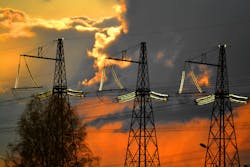Systems Thinking: Advanced Technologies Behind Intelligent Substation Design
At a Glance:
- Which technologies people use to design substations.
- What kinds of results they can expect.
When you think of an intelligent substation, what comes to mind? It’s becoming more common for these facilities to have connected sensors, digital twins and other high-tech advancements that help them run smoothly. An industrial substation is such a vital facility that people must know about any associated problems as soon as possible, in hopes they’ll rectify the matter as quickly as is feasible. Many people are exploring which advanced technologies best fit their needs.
Intelligent Substation Functionality and Design Through Automation
Using automation to support a substation’s operation can reduce manual tasks and raise awareness. For example, some utilities rely on Internet of Things sensors to detect abnormalities such as oil spillage. Sometimes, the insulating oils used by transformers and other industrial equipment can leak, which may pollute local waterways. Connected sensors can recognize and immediately flag such issues. The sensors are also advantageous at unstaffed substations, giving people the peace of mind that everything is operating as it should, even if they can’t physically verify that fact.
Industrial substation designers can also rely on automated tools and features during their processes. For example, a project management system that works in the cloud can automatically send task notifications to the appropriate parties, letting them know what they must achieve on a given day. Similarly, some electronic design platforms automatically capture schematics, making the associated information easier to edit and share with others.
READ MORE: 4 Tips for Securing Industrial IoT Networks
When Australia’s South Erskine Park zone substation was the first to digitize fully, the people involved noticed numerous advantages. For example, working with digital design tools revealed they could save money and achieve smaller project footprints by using modular buildings on the site. This approach saved about 25% per substation project.
The project’s commissioning timeframe was also significantly shorter at about 15 months—down from the estimated three years before the digitalization occurred. Investing in digitalization made those involved more responsive to changing development needs.
Relatedly, people can start planning much earlier than they did previously. The designers took a cue from the manufacturing world by prioritizing just-in-time design rather than beginning the process several years earlier, meaning fewer items to change between the design and rollout stages.
Industrial Substation Designs Enhanced with Digital Transformations
Some professionals in the power industry realize they’ll gain numerous benefits by working toward operating a digitally transformed substation and power plant. However, what constitutes a digital transformation does not look the same for every facility. A good starting point is for people to discuss what has compelled them to pursue digital transformation.
More specifically, pressure from competitors is an insufficient reason by itself. While it may be true that your industrial substation is not yet as high-tech as others, digital transformation discussions must be more in-depth, exploring what people hope to achieve by designing and operating an intelligent substation.
READ MORE: The Future of Connected Worker Technology and Its Impact on Industrial Training
In one example, those who used digital technologies on a substation project in Central China found the approach provided substantial time-saving potential. The tools included a digital twin and a fully collaborative digital design platform.
Investing in this digital transformation reduced the construction timeline by 30 days because the teams avoided more than 50 rework events. Using the integrated technologies saved the equivalent of $38.7 million during the project. Designers also found ways to be less disruptive to the surrounding farmland as work progressed.
However, anyone overseeing a digital transformation must realize all technologies used—from Internet of Things sensors to smart access control systems—could become aspects for hackers to target. Cybersecurity must remain a top-of-mind issue to increase the chances of digital transformations getting the desired outcomes and staying largely trouble-free.
Artificial Intelligence and Computer Vision Ease Design Challenges
People involved in industrial substation design know there are numerous things to account for throughout the process. That’s particularly true if the ongoing work requires moving or replacing some existing equipment. Substation transformers may weigh up to 1,200,000 lb, proving why individuals must think carefully and rely on professionals before proceeding.
In one case, researchers wondered how to pursue more intelligent substation design practices using artificial intelligence and computer vision tools to accelerate the tender process. The best tender processes are agile and fast, and this team hoped to achieve a knowledge-sharing solution by combining those two advanced technologies. They also developed a project configuration system that relied on computer-aided design template files.
The team built a novel framework to achieve their goals and experiments showed it got the desired results. People could use it to create 3D models of substations from single-line drawings in less time than conventional methods allowed. Researchers envision their innovation will assist substation design companies’ competitiveness by enabling the professionals working at them to automate some parts of the tender-answering process without sacrificing engineering quality.
Virtual Reality to Accelerate Substation Training Methods
Analysts expect 2024 to be a challenging year for construction. A primary reason is they believe the enduring labor shortages that have posed obstacles in previous years will continue. However, some experts who weighed in on the matter think decision-makers will start tackling the problem by changing how they address training needs for newer workers. If staff can get the real-world education they need sooner, they’ll become well-equipped to contribute efficiently to reducing shortages.
In one research-based example, a team developed virtual reality simulators to prepare people to work at substations. They took modeling information from a real-world substation to create the scenarios, all of which covered the safety-related specifics of working at an operational substation.
READ MORE: Digital Twins: Designing Virtual Replicas of Infrastructure Projects
The group wanted to use actual equipment data and other workplace-specific aspects, hoping these details would help learners feel more motivated about vocational training. They designed three simulations to walk trainees through operations, maintenance and resolving failures. Although their experiments only involved 16 substation professionals, the results indicated virtual reality was a suitable training method, even for those unfamiliar with the technology.
Although this group did not explore the possibility, it’s easy to see how they could make design-related simulations, as well. Besides supporting newer designers, this approach could increase client confidence and communications so everyone involved can see the progress in a virtual environment
Apply Advanced Technologies for Better Substation Design Outcomes
There’s no single best way to focus on intelligent substation design. However, these examples show people are getting meaningful outcomes by being open to using new technologies and having clear ideas for what they want to achieve.
Emily Newton is a technology and industrial journalist. She is also the editor-in-chief of Revolutionized. She has more than five years covering stories about warehousing, logistics and distribution.
About the Author

Emily Newton
Emily Newton is a technology and industrial journalist. She is also the editor in chief of Revolutionized. She has over five years covering stories about warehousing, logistics and distribution.
